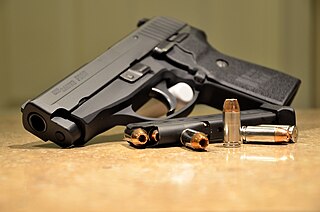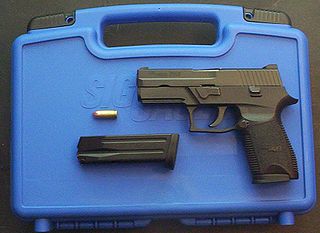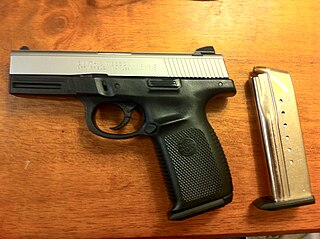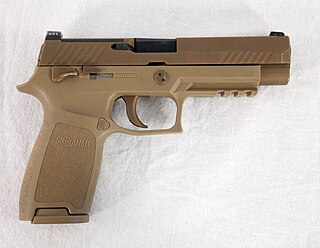 W
WThe Arsenal Firearms "Strike One" is a polymer or Ergal-framed, short recoil operated, striker-fired semi-automatic pistol introduced by the company Arsenal Firearms in 2012. The Strike One is known in Russia as the «Стриж».
 W
WThe Beretta 8000 (Cougar) series pistols are manufactured by Beretta of Italy.
 W
WThe Caracal pistol is a series of semi-automatic pistols manufactured by Caracal International LLC a subsidiary of Tawazun Holding from the United Arab Emirates. The Caracal pistol series are the first pistols made in the United Arab Emirates and is the primary service issued pistol used by the United Arab Emirates Armed Forces.
 W
WThe FN FNP pistol is a series of semi-automatic, polymer-framed pistols manufactured in Columbia, South Carolina, by FNH USA, a division of Fabrique Nationale de Herstal. The pistol debuted in early 2006 and is chambered for the 9×19mm Parabellum, .40 S&W, .45 ACP, and .357 SIG cartridges.
 W
WThe Glock is a series of polymer-framed, short recoil-operated, locked-breech semi-automatic pistols designed and produced by Austrian manufacturer Glock Ges.m.b.H. The firearm entered Austrian military and police service by 1982 after it was the top performer in reliability and safety tests.
 W
WThe Heckler & Koch P2000 is a German semi-automatic pistol introduced late in 2001 and intended primarily for law enforcement, paramilitary, and commercial markets. It is based on the USP Compact pistol. The P2000 was designed specifically with improved ergonomic characteristics; it has features that reduce handling related stresses, while at the same time increasing user handling and comfort.
 W
WThe USP is a semi-automatic pistol developed in Germany by Heckler & Koch GmbH (H&K) of Oberndorf am Neckar as a replacement for the P7 series of handguns.
 W
WThe HS2000 is a series of semi-automatic pistols. Polymer-framed and striker-fired, the series is manufactured by HS Produkt in Karlovac, Croatia. In Europe, the pistols are marketed as the HS and XDM series, while in the United States, the pistols are sold as the Springfield Armory XD and XD-M series, respectively. Other derivative variants sold by Springfield Armory, Inc., are unique to the American market.
 W
WThe SIG Pro is a series of semi-automatic pistols developed by SIG Sauer in Exeter, New Hampshire. It became the first polymer-frame handgun from SIG Sauer and one of the first pistols to feature a built-in universal accessory rail and interchangeable grips. Offerings in the series are chambered in .40 S&W, .357 SIG, or 9×19mm Parabellum. As of March 2020, only the SP 2022 variant is still listed on the SIG Sauer website. The SIG Pro was marketed as a lightweight and compact alternative to the "legacy" SIG Sauer handguns in an increasingly competitive and budget-oriented law enforcement market.
 W
WThe SIG Sauer P226 is a full-sized, service-type pistol made by SIG Sauer. This model is sold with a choice of four chambers to choose from: the 9×19mm Parabellum, .40 S&W, .357 SIG, or .22 Long Rifle. It has essentially the same basic design as the SIG Sauer P220, but is developed to use higher capacity, double stack magazines in place of the single stack magazines of the P220.
 W
WThe SIG Sauer P239 is a semi-automatic pistol designed and manufactured by SIG Sauer—both SIG Sauer GmbH in Germany and SIG Sauer Inc. of New Hampshire, United States. It was produced from 1996 to 2018, and offered in three calibers: 9×19mm Parabellum, .357 SIG and .40 S&W. The P239 became popular in the United States as a concealed carry pistol.
 W
WThe SIG Sauer P250 is a semi-automatic pistol made by Sigarms. Introduced in 2007 the SIG P250 can be chambered in .22 Long Rifle, .380 ACP, 9×19mm Parabellum, .357 SIG, .40 S&W, and .45 ACP. The P250 chambered in 9×19mm Parabellum was introduced to the North American market on November 7, 2007 followed by the .45 ACP compact model in February 2008 at the SHOT Show. The last of the models were introduced in late 2009.
 W
WThe SIG Sauer P320 is a modular semi-automatic pistol made by SIG Sauer, Inc. of Exeter, New Hampshire, and SIG Sauer GmbH of Eckernförde, Germany. It is a further development of the SIG Sauer P250, utilizing a striker-fired mechanism in lieu of a double action only hammer system. The P320 can be chambered in 9×19mm Parabellum, .357 SIG, .40 S&W, and .45 ACP, and can be easily converted from one caliber to another—a change from .357 SIG to .40 S&W requires only a barrel change; a change between 9mm to .357 SIG or .40 S&W and vice versa are accomplished using a caliber exchange kit.
 W
WThe Smith & Wesson M&P is a polymer-framed, short recoil operated, locked breech semi-automatic pistol introduced in the summer of 2005 by the American company Smith & Wesson. It uses a Browning-type locking system. While targeted at law enforcement agencies, the M&P is also widely available on the commercial market.
 W
WThe Smith & Wesson SD, formerly known as the Sigma, was Smith & Wesson's first venture into using synthetic materials in pistol construction, using high-strength polymer material for the frame. The pistol is similar to a Glock safe-action pistol in both its design and operation, leading to controversy and speculation regarding the pistol's patents' legality.
 W
WThe Springfield Armory XD is a series of semi-automatic pistols sold by Springfield Armory, Inc., in the United States along with follow-on variants: XD-M, XD-S, and XD-E. Polymer-framed and predominantly striker-fired, the series is manufactured by HS Produkt in Karlovac, Croatia.
 W
WThe Steyr M is a series of semi-automatic pistols developed by Steyr Mannlicher GmbH & Co KG of Austria for police services and the civilian shooting market. Design work on the new pistol began in the early 1990s and the final product known as the M9 was officially unveiled in the spring of 1999. The M40 version chambered in .40 S&W was developed before the M9, followed later by the M357 and two smaller variants of the M9 and M40 designated the S9 and S40 respectively. These pistols were developed primarily for concealed carry and have a shortened barrel, slide, smaller frame and a reduced magazine capacity. In 2013 the Steyr M (Medium) and S (Small) form factors were complemented by the L (Large) sized series and the C (Compact) sized series both available in 9×19mm Parabellum and .40 S&W chamberings as the L9-A1, L40-A1, C9-A1 and C40-A1.
 W
WThe XM17 Modular Handgun System (MHS) competition was a United States Army and United States Air Force competition for a new service pistol. The Modular Handgun System was solicited by a Request for Proposals in September 2015 and is anticipated to be the next U.S. military standard side arm replacing the Beretta M9 pistol and the SIG Sauer M11. The U.S. Marine Corps also participated in the program to have input on source selection, but likely will not order the resulting weapon until their current pistols' life-cycles end in the mid-2020s.